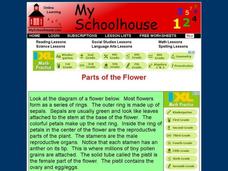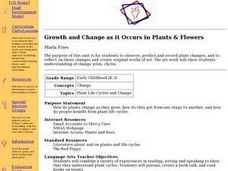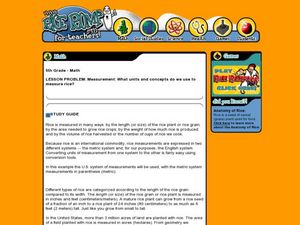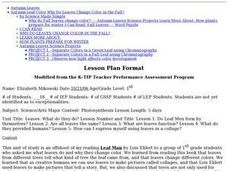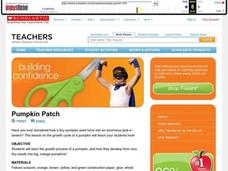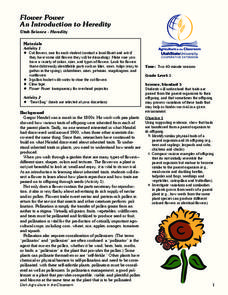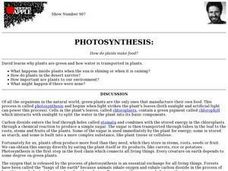Curated OER
Parts of the Flower
In this biology worksheet, students examine a diagram of a flower and read a selection that describes all of the parts including the petals, the stamen, the anther, and the sepals. They answer 11 on-line fill in the blank questions using...
Curated OER
Flipbook Succession
Students review succession charts for their native area before going to an outside site to view the changes. At the site, they follow the transect line and observe the changes in the plant life. They draw the changes on note cards that...
Curated OER
Pollination Station
Students investigate why and how bees pollinate flowers and other plants. They define pollination, and read and sing along with the song "Yo, i'm a Flower." Students examine a diagram of a flower, simulate bees pollinating flowers, and...
Curated OER
Getting a Handle on Your Bee
Students observe dried bees, carefully glue them to toothpicks, and use them for cross pollinating their Brassica plants. They also describe reasons why two similar investigations can produce different results. Finally, students...
Curated OER
Growth and Change as it Occurs in Plants and Flowers
Students work together to observe plants and flowers through their life cycle. In groups, they make predictions and record changes in a journal. Using this information, they create their own original artwork and discuss the plants life...
Curated OER
Practice Writing and Evaluating Conclusion Paragraphs
In this writing conclusions worksheet, students practice writing and evaluating paragraphs written at the end of an experiment. They are given a hypothesis and a results sentence and they write a conclusion.
Curated OER
The Economics of Organic Agriculture
Students examine how organic agriculture affects farm profitability and how government programs affect organic agriculture. In this organic agriculture lesson students complete an activity on costs and returns.
Curated OER
Understanding Life System: Growth and Changes in Plants
Third graders research ways in which plants are essential to humans. In this Global Peace lesson, 3rd graders participate in tasks, such as creating a propaganda poster. Students may watch the film, The Lorax, as a closing activity.
Curated OER
Rice Straw
Third graders read about rice farmers and their left over straw and then draw pictures that show how they help migrating birds. In this rice straw lesson plan, 3rd graders read about how the rice farmers use their straw to help the birds...
Curated OER
What units and concepts do we use to measure rice?
Fifth graders look at different ways to measure rice. In this rice measurement lesson, 5th graders see the metric and customary measurements. They discuss how rice is measured by length, area of the field, weight, volume and yield.
Curated OER
Leaf Unit
Students complete a unit on leaves and their functions. They identify leaves and the trees they belong to, read various books, observe the process of photosynthesis on a flannel board, and create a leaf collage.
Curated OER
Investigation Xylem
Students investigate how water travels up the stem of vascular plants by using food coloring to stain the xylem of a number of different plants. They know the function of leaves, stems, and root at the end of the experiment.
Curated OER
Pumpkin Patch
Pupils create a pumpkin art project that outlines the life cycle of a pumpkin in order to learn the growth process of this particular vegetable. In this pumpkin art lesson, students first review the life cycle of a pumpkin as a class,...
Curated OER
Flower Power: An Introduction to Heredity
Students observe flowers and how they grow according to heredity. In this flowers lesson plan, students observe physical traits that make flowers the offspring of other flowers, and fill out worksheets according to their findings.
Curated OER
Agriculture in Motion
Youngsters learn about simple machines that could be used on a farm. They learn about agricluture, listen to a farmer speak, compare and contrast different farm machines, and then design their own. Note that although the publisher...
Curated OER
Halloween Literature Unit: Pumpkin Patch Unit Project
Students simulate an agriculture project. In this sequencing lesson, students observe their classroom pumpkin patch, make journal entries, and predict how the pumpkins will grow. They discuss as a class how to keep their pumpkins safe...
Curated OER
Animals
First graders study the basic needs of animals and compare them to human needs. They make bird feeders using milk carton and pine cones. They review the basic needs of food, water, air, and shelter and discuss what happens when animals...
Curated OER
Forests and Photosynthesis
Fourth graders explore the concept of photosynthesis. They investigate the effects of light on seedlings. Students grow plants and record the data. Students view satellite images that show the monthly amount of vegetation present in the...
Curated OER
The Sparrow
In this reading comprehension worksheet, students read a detailed one page story which gives facts about sparrows. Students answer 4 questions.
Curated OER
Drawing From Nature
Students observe similarities and differences of natural objects. In this observation lesson, students use a magnifying glass to identify the details of objects.
Curated OER
Taking Care of Nature (Religious)
Students discover how they can help care for the earth. In this environmental protection lesson, students discuss how God created the earth and what will happen if they fail to care for the earth properly. Students grow their own...
Curated OER
Photosynthesis: How do plants make food?
Students study why plants are green and how water is transported in them. They examine how plants respond to different amounts of light.
Curated OER
Forest Food Web
Students explore the elements of a forest ecosystem. They examine the elements needed to form a forest food web. Students construct and describe food webs that include nonliving elements of the ecosystem.
Curated OER
Container Gardening: Vegetable Support
In this container gardening: vegetable support activity, students list vining and bush varieties of 6 vegetables, read about ways of supporting plants and list other things plants can grow on.


